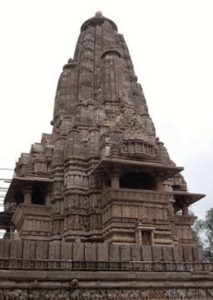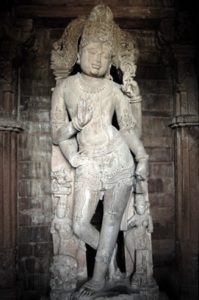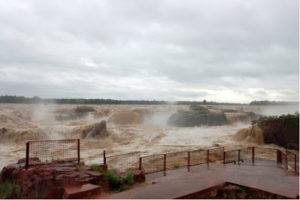Khajuraho, Raneh Falls, Madkhera, Deogarh
It was time to head to Khajuraho (from Bheda Ghat).
It was a long journey of more than 6 hours. We sat back and relaxed. By evening we were driving through the small outstretched portion of the Panna N.P., en route to Khajuraho. We had heard that a certain Pandava Falls was somewhere in the vicinity. Our inquiries with the locals did not yield any info. We were instead ‘guided’ to ‘Pandavan’ – about 10 kms from where we enquired. After some deliberation, we decided to take the deviation. After about 10 kms, mostly intruding into the privacy of 'relieving' humans, we came to a fairly long bridge. That was what was 'Pandavan'. Except for the assumed thrill of being in some desolate area on a bridge with broken side walls and enjoying the gusty breeze, there was little there. Naturally, G. did not like it. He detested the idea of us 'enjoying' (potential) danger. It was not thrilling at all for him. After all, the thrill is in the possibility of danger! We were reprimanded quite sharply for ignoring our own maturity. In retrospect, we deserved the reprimand! It was not really prudence to loiter in a remote unknown area in the dark. Anyways, we proceeded to Khajuraho.
[contextly_sidebar id="igcTUElgpGeg82d0lXSiz3qPCqSFl57M"]We reached Khajuraho at around 8:00 PM. We found accommodation quite easily. After refreshing ourselves, we had dinner at a restaurant close by and then retired for the night.
The next day’s morning began with some tasty Parothas and masala tea. We headed to the temple complex in a lot of anticipation. The Western Group of temples is the largest of the temple groups and is the richest in sculpture. We were perhaps anticipating for what Khajuraho has been portrayed to the world for – eroticism!
The Khajuraho temples incidentally were built in a short but inspired span of less than 150 years, between 950 and 1100AD! They were built under the patronage of the Chandela Rajput kings. Kharjuravaaha, as was its original name was well protected by dense forests and therefore remained well-preserved.As we enter the temple complex, on the left side
As we enter the temple complex, on the left side at the entrance is a huge Varaha, its body completely covered in intricate carvings of Gods, Goddesses, and other figurines. Beside this is the small but intricate temple dedicated to the Goddess Lakshmi. The first main temple as we start from the left is the ‘Lakshmana’ temple dedicated to Vishnu.
As also is the ritualistic norm, we began to go around the temple clockwise. On the left wall, at the plinth level are a series of erotic carvings, exquisite and explicit. And high on the side walls were large panels of erotic sculptures. And amidst them were exquisite sculptures of Brahma, Shiva-Parvati, Sarasvati, Ganesha, and a host of other Gods and Goddesses. On the plinth, beside the erotica are the armies at war, the horses, elephants, warriors, musicians, and drummers depicting a wide variety of life and culture.
As we went around, we soon realized that erotica occupied only a very small portion of the temple walls. It was as if, to make it just enough to elevate carnality to divinity and not so much to draw divinity down. The Lakshmana temple perhaps has the best of the sculptures. The most graceful of the sculptures adorns the walls of Lakshmana temple. We went around, as usual with commentary! The next temple adjacent to the Lakshmana temple on its right (in fact, it is to the right to the person facing the temple) is the central Kandariya Mahadev temple. It is the biggest temple in the complex and looks the grandest from a distance.
When we had begun in the morning, we were in a hurry. Especially G. There was a lot to be covered at Khajuraho, or that’s what we thought. We went around the Kandhariya Mahadev temple. There were some more of those exquisite sculptures. The erotica was just a small fraction of them. A very small fraction! Prominent on the side walls are large panels of rather bold depictions. But contrary to what we had expected, Khajuraho seemed to be thriving on a false propaganda. Amidst the wonderful benign sculptures were only a few depictions of basal passions as if to elevate them too. Nevertheless, Khajuraho has a lot to offer to a connoisseur of shilpa.
Though there are a number of isolated beauties, we noticed one distinct pattern (or lack of it) in all of the temples. The sculptures were not based on any popular theme, be it on the epics or the Puranas. This intrigued us. Khajuraho seemed as a continuation of the Udayapura style. But, the variety had been compromised. They lacked the strength of the Puranas or the epics to drive a complete picture. Though exquisite in isolation, they lacked the strength of tradition to back them. This perhaps was an indication of the downward spiral of the arts subsequent to the classical period. We have to make a special mention of the glut of yaaLis that dotted the walls in abundance. This repetitive and monotonous recurrence showed imagination in only how multiple yaaLis could intertwine in continuity. Every corner of the temple was without exception an abode of the yaalis. Sometimes, as if to break the monotony were their cousins – the sharabhas and the saalvas . We went around peeking in-between carefully. G. characteristically was ahead of all of us. He had set a blazing speed. We had to catch up lest we missed the commentary. But he kept moving ahead lest we miss Khajuraho itself. V’s penchant for detail ensured we went slow. Somewhere caught between G. and V. was me trying to bridge the gap. It was mostly futile anyway. I missed the commentary on one side and the detail on the other!
The weather was most pleasant. The clouds shaded us from the Sun throughout. Khandariya Mahadev had seen us do the parikrama. It was much quicker at the rest of the temples in the complex. We had finished it in good time and missed nothing. The main temple complex was done. A couple of other temples, the Chaturbhuja and the Zaveria temples were a little distance away. The Jain temple complex too was a short distance away. We decided to go to the Chaturbhuja temple next. This temple was one of the most surprising – for, it’s a small not-so-well kept temple quite a distance from the main temple complex, but was abode to one of the most marvelous sculptures that we had seen in the entire trip. The more than life-size deity was indeed striking. The poise, the balance, the serenity on the face could so easily make us truly see God in stone. This could well have been the ambassador for Khajuraho.
It was beyond lunch time already. We decided to finish lunch and then proceed to the Jain temples. We headed back to the same restaurant that we already had frequented twice. Just as we entered, the skies opened up in a sudden and mighty downpour. It grew dark. We became apprehensive of our further plans. Neverthless, the immediate thought was only to first finish lunch. We did that as quickly as he could serve. The rains were still unrelenting. We decided to go the ASI museum which was just a few buildings away from the restaurant. We drove right under the portico of the museum entrance and headed straight in to avoid getting drenched. The ASI museum is refreshingly well-maintained and houses very many beautiful and well described sculptures. We spent a good 30 mins there. And just as we were done, the rains subsided! It is quite a mystery why the rains were so cooperative throughout.We then went to the Jain temple complex. The Parshwanatha and Adinatha temples, though enchanting in some ways was still a pale comparison to the grandeur we had seen at the Lakshmana temple complex. There were far too many repetitions and again was not backed by popular themes. The next and the last for the day was the
We then went to the Jain temple complex. The Parshwanatha and Adinatha temples, though enchanting in some ways was still a pale comparison to the grandeur we had seen at the Lakshmana temple complex. There were far too many repetitions and again was not backed by popular themes. The next and the last for the day was the Zaveria temple. We went there just before sunset. After the usual examination of the sculptures, we sat down in the temple to watch the sun set. It was almost becoming a habit for us –to sit the watch the Sun go down and as it did, the day’s memories would sink in too.
JM had made his return booking from Delhi the next day and therefore made arrangements to leave Khajuraho that evening and reach Delhi the next morning. We had booked a train ticket to Delhi. He was returning to Bangalore a day ahead of us. We then went to the railway station to bid JM goodbye. Oh! His company was so remarkable! Our only consolation was that it would only be a day that we would miss his company. After we waved goodbye enough and the train was almost out of sight, we returned back. We then decided to go to the Shiva temple that was just beside the Lakshmana temple (complex) [I forget the name]. The rain was threatening yet again. We nevertheless decided to make a quick visit and thank the Lord too for making Khajuraho such a memorable and pleasant visit. There is a huge Shiva linga in the temple. We climbed onto the peetha itself to go around the actual linga. Just as we took the tirtha, the warnings were getting louder. Thunder and lightning began to strike in unison. We ran back to the TT, headed straight back to our lodge and scampered inside just as the downpour began in right earnest. The rest of the evening was spent in the room, indulging as usual in serious discussions about human relationships, problem-solving, emotional balance and imbalance, behavioral unpredictability and every other complex psychological paradigm. And like most other days, we psyched ourselves to sleep from intellectual fatigue!The next day, we had decided to leave early and visit one Raneh falls. This, we had
The next day, we had decided to leave early and visit one Raneh falls. This, we had learnt was just about 25 kms from Khajuraho and that it was a beautiful waterfall on the river Ken – Karnaavathi. We were at the gate of the National Park’s entrance at 7AM. The entrance fees was a prohibitive Rs.400! We cribbed and paid. We entered the NP and traveled on a levelled mud road, quite mucky and slushy after the rains. We were told that we have to travel on this 'kutcha' road for a kilometer and a half. It was raining lightly. The winds were frolicking over the enlivened foliage. The whole forest seemed to come alive in a boisterous mood. After a little distance, we began to hear the 'falls'. It was not in sight though. Then suddenly, to our right was a vast vista of water, an expanse of a river that none of us had ever seen before! It was vast, fast and furious. It was the first time perhaps we could relate to what a flood means. Even a lesser-known river, Ken looked so devastating. We gasped in wonder as much as we stood away in fear. Neverthless, from a few vantage points, we photographed the river's expanse and fury. We drove further ahead to a point from where we were supposed to view the actual falls. Fenced embankments have been constructed to get as close to the river as is safe. The huge expanse of water converges at the cataract and then flows through a canyon, much like the Grand Canyon.
At the closest point to the 'falls', the experience is simply inexplicable. It is futile to even attempt an explanation in words. A waterfall of over a hundred feet was now a short 5 feet! We could not even imagine that there is in fact a falls that high, until we saw a photo of it later at the coffee shop. The volume of water had just swallowed the very identity of the falls. Only then did we realise that there is indeed a falls there! It was poetic that being too full of itself altered its own identity. Ofcourse, poetry had to follow - the waters seemed like the very molten core of the Earth gushing out and flowing in the canyon. (Apologies to G. Can't remember the exact representation).
The roar has only to be heard. But, even the deafening loudness had some unknown harmony. It never felt like noise. From a distance, from where the river ceased to threaten, the sound was indeed soothing and even the turbulent sight lent to tranquility. We then walked a little distance further ahead to another viewpoint. From here, we get a wonderful bird's eye view of the river, the falls and the canyon. It's a perspective that maintaining a certain distance can provide.
The last place in MP on our itinerary was Deogarh. After a not-so-fulfilling Madkhera where the Sun temple exists, we reached Deogarh by evening. We first went to the museum just at the entrance of the ASI complex. Many a wonderful sculpture has been preserved at the museum. It was almost closing time. And it was getting darker too. We went to the temple. We knew what to expect. The four panels on the four sides of the temple walls, each in itself an enthralling beauty, would justify a visit just for their sake. Just the panels of the reclining Vishnu on the Adishesha, Nara-Narayana, Gajendra Moksha, and Krishna with Yashoda and Nandagopa make the visit there so fulfilling.
We went around the temple three times, appreciating better each time, the aesthetic details in the sculptures. The Sun was setting and was slowly getting darker. Our sight now befell on the environs of Deogarh. Small hills and hillocks, thickly wooded surround the place. The rains had rendered them a wonderful green foliage. It dawned then that Deogarh could well be the ‘Devagiri’ in the Meghadootha. Our sojourn too had ended there. The megha and the meghadootha had so wonderfully kept us company throughout. It was a feeling of deep gratitude that we could not ignore. We took the last snap of the trip in the light of the retiring Sun – a group photo with Paramaar with the TT in the background. It was a grand finale. We rejoiced with a sense of achievement.
We had begun with a group snap at Ujjain. We ended thus. With the flash was the flash of lightning. We began the final leg of the journey to Jhansi. We reached Jhansi at around 8 and as usual with a few inquiries, went to a 'hotel' for dinner. We had intended to go to a nice, posh restaurant, but landed in a dhaba-like hotel. Anyway, the food was good. We finished a quick dinner and then settled the payment to Paramaar. He then dropped us to the Railway station and took leave of us. His company was indeed memorable. We bid him a heartfelt goodbye.
We had a few hours to spend at the Jhansi Railway station. We made ourselves comfortable in a fairly clean area on the platform. We sat in the railway station at Jhansi musing in the thought that our MP trip had come to an end. We would be in Bangalore-back home the next day. As the trains came and went by hooting, so did the memories of the last 8 days. We had a whole load to carry as memories of the trip. It shall last a lifetime. MP is indeed a HUGE state. We had traveled well over 2000 kms covering quite an impressive area spread across the state. We revisited every place again. We thought of the wonderful weather that had made the whole trip so pleasant. Of the rains that had shadowed us everywhere, but never once disrupted us. It had instead made the lands so much greener, richer and so lively. We thought of the nice people of Madhya Pradesh. We remembered the ragged man at the non-descript dhaba en route Omkareshwar who refused to give the jalebis citing that they were not fresh! We had driven through a number of small villages and towns across the state. It seemed that the people were contented. There was an abundance of cows and buffaloes. A lot of the rural economy seemed to subsist on animal husbandry apart from agriculture of course. We saw little of mass industrialization. The villages though are poor from today’s yardsticks, are strikingly clean. Unlike in a few other states, the density of population was not felt. It was in all a very pleasant experience, especially for a traveler. We carry a whole lot of memories with us. And obviously, no matter how many pages we write, it's only a pale reflection from memory.
We took the train to Delhi and then went to the Airport to take our flight back to Bangalore. At around 8:30 in the evening, we were all home.

















































